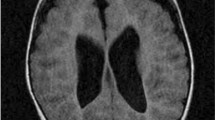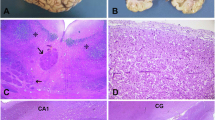Abstract
We report treatment outcome of eleven patients with pyridoxine-dependent epilepsy caused by pathogenic variants in ALDH7A1 (PDE-ALDH7A1). We developed a clinical severity score to compare phenotype with biochemical features, genotype and delays in the initiation of pyridoxine. Clinical severity score included 1) global developmental delay/ intellectual disability; 2) age of seizure onset prior to pyridoxine; 3) current seizures on treatment. Phenotype scored 1–3 = mild; 4–6 = moderate; and 7–9 = severe. Five patients had mild, four patients had moderate, and two patients had severe phenotype. Phenotype ranged from mild to severe in eight patients (no lysine-restricted diet in the infantile period) with more than 10-fold elevated urine or plasma α-AASA levels. Phenotype ranged from mild to moderate in patients with homozygous truncating variants and from moderate to severe in patients with homozygous missense variants. There was no correlation between severity of the phenotype and the degree of α-AASA elevation in urine or genotype. All patients were on pyridoxine, nine patients were on arginine and five patients were on the lysine-restricted diet. 73% of the patients became seizure free on pyridoxine. 25% of the patients had a mild phenotype on pyridoxine monotherapy. Whereas, 100% of the patients, on the lysine-restricted diet initiated within their first 7 months of life, had a mild phenotype. Early initiation of lysine-restricted diet and/or arginine therapy likely improved neurodevelopmental outcome in young patients with PDE-ALDH7A1.



Similar content being viewed by others
References
Bok LA, Halbertsma FJ, Houterman S et al (2012) Long-term outcome in pyridoxine-dependent epilepsy. Dev Med Child Neurol 54:849–854
Coughlin CR 2nd, van Karnebeek CD, Al-Hertani W et al (2015) Triple therapy with pyridoxine, arginine supplementation and dietary lysine restriction in pyridoxine-dependent epilepsy: neurodevelopmental outcome. Mol Genet Metab 116:35–43
Gallagher RC, Van Hove JL, Scharer G et al (2009) Folinic acid-responsive seizures are identical to pyridoxine-dependent epilepsy. Ann Neurol 65:550–556
Gospe SM Jr (2014) Pyridoxine-dependent epilepsy. In: Pagon RA, Adam MP, Ardinger HH, Wallace SE, Amemiya A, Bean LJH, Bird TD, Fong CT, Mefford HC, Smith RJH, Stephens K (eds) GeneReviews® [Internet]. Seattle (WA): University of Washington, Seattle; 1993–2015. 2001 [updated 2014]
Jain-Ghai S, Mishra N, Hahn C, Blaser S, Mercimek-Mahmutoglu S (2014) Fetal onset ventriculomegaly and subependymal cysts in a pyridoxine dependent epilepsy patient. Pediatrics 133:e1092–e1096
Kanno J, Kure S, Narisawa A et al (2007) Allelic and non-allelic heterogeneities in pyridoxine dependent seizures revealed by ALDH7A1 mutational analysis. Mol Genet Metab 91:384–389
Mahajnah M, Cordeiro D, Austin V et al (2016) A prospective case study of the safety and efficacy of lysine restricted diet and arginine supplementation therapy in a patient with pyridoxine-dependent epilepsy caused by mutations in ALDH7A1. Pediatr Neurol. doi:10.1016/j.pediatrneurol.2016.03.008
Mercimek-Mahmutoglu S, Horvath GA, Coulter-Mackie M et al (2012) Profound neonatal hypoglycemia and lactic acidosis caused by pyridoxine-dependent epilepsy. Pediatrics 129:e1368–e1372
Mercimek-Mahmutoglu S, Cordeiro D, Cruz V et al (2014) Novel therapy for pyridoxine dependent epilepsy due to ALDH7A1 genetic defect: Larginine supplementation alternative to lysine-restricted diet. Eur J Paediatr Neruol 18:741–746
Mercimek-Mahmutoglu S, Sidky S, Hyland K et al (2015) Prevalence of inherited neurotransmitter disorders in patients with movement disorders and epilepsy: a retrospective cohort study. Orphanet J Rare Dis 10:12
Mikati MA, Trevathan E, Krishnamoorthy KS, Lombroso CT (1991) Pyridoxine-dependent epilepsy: EEG investigations and long-term follow-up. Electroencephalogr Clin Neurophysiol 78:215–221
Mills PB, Struys E, Jakobs C et al (2006) Mutations in antiquitin in individuals with pyridoxine-dependent seizures. Nat Med 12:307–309
Mills PB, Footitt EJ, Mills KA et al (2010) Genotypic and phenotypic spectrum of pyridoxine-dependent epilepsy (ALDH7A1 deficiency). Brain 133:2148–2159
Nasr E, Mamak E, Feigenbaum A, Donner EJ, Mercimek-Mahmutoglu S (2015) Long-term treatment outcome of two patients with pyridoxine-dependent epilepsy caused by ALDH7A1 mutations: normal neurocognitive outcome. J Child Neurol 30:648–653
Plecko B, Paul K, Paschke E et al (2007) Biochemical and molecular characterization of 18 patients with pyridoxine-dependent epilepsy and mutations of the antiquitin (ALDH7A1) gene. Hum Mutat 28:19–26
Salomons GS, Bok LA, Struys EA, Pope LL, Darmin PS, Mills PB, Clayton PT, Willemsen MA, Jakobs C (2007) An intriguing “silent” mutation and a founder effect in antiquitin (ALDH7A1). Ann Neurol 62:414–418
Stockler S, Plecko B, Gospe SM Jr et al (2011) Pyridoxine dependent epilepsy and antiquitin deficiency: clinical and molecular characteristics and recommendations for diagnosis, treatment and follow-up. Mol Genet Metab 104:48–60
Van Karnebeek CD, Hartmann H, Jaggumantri S et al (2012) Lysine restricted diet for pyridoxine-dependent epilepsy: first evidence and future trials. Mol Genet Metab 107:335–344
Van Karnebeek CD, Stockler-Ipsiroglu S, Jaggumantri S et al (2014) Lysine-restricted diet as adjunct therapy for pyridoxine-dependent epilepsy: the PDE consortium consensus recommendations. JIMD Rep 15:1–11
Yuzyuk T, Thomas A, Viau K, Liu A, De Biase I, Botto LD, Pasquali M, Longo N (2016) Effect of dietary lysine restriction and arginine supplementation in two patients with pyridoxine-dependent epilepsy. Mol Genet Metab 118:167–172
Acknowledgements
We would like to thank to parents and patients. We would like to thank to Mrs. L. Nagy, metabolic dietician and Mrs. S. Herd, metabolic dietician for the application of lysine-restricted diet. We would like to thank to Dr. G. Salomons for performing mutation analysis of ALDH7A1. We would like to thank to Dr. Siriwardena, Dr. Donner, Dr. Raiman and Dr. Peter Humphreys referring their patients. We would like to thank to Stacy Hewson for genetic counseling of families for molecular genetic test results.
Author information
Authors and Affiliations
Corresponding author
Ethics declarations
Conflict of interest
The authors declare that they have no conflict of interest.
Ethical approval
Institutional Research Ethics Board approved the study (Approval#1000050808).
Electronic supplementary material
Supplemental Figure 1
Clinical severity score compared to the X-fold elevated in the upper limit of normal urine and plasma α-AASA levels in eight patients with no lysine-restricted diet initiated within their first 7 months of life (except patient ID# 5, 8 and 11) with PDE-ALDH7A1. *Values for these patients are from plasma α-AASA level. (JPEG 46 kb)
Supplemental Table 1
Neuropsychological assessment results on treatment in patients with PDE-ALDH7A1. (DOCX 30 kb)
Rights and permissions
About this article
Cite this article
Al Teneiji, A., Bruun, T.U.J., Cordeiro, D. et al. Phenotype, biochemical features, genotype and treatment outcome of pyridoxine-dependent epilepsy. Metab Brain Dis 32, 443–451 (2017). https://doi.org/10.1007/s11011-016-9933-8
Received:
Accepted:
Published:
Issue Date:
DOI: https://doi.org/10.1007/s11011-016-9933-8




